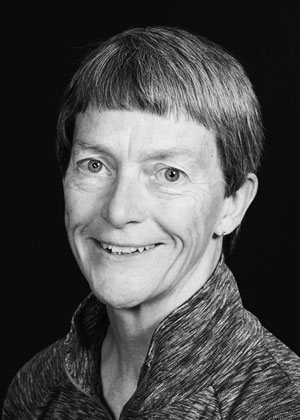Citation

Since the beginning of the space age, the environment outside Earth’s neutral atmosphere has been a laboratory for fundamental plasma physics, for the interaction of the solar wind with the bodies of the solar system, and for phenomena that impact our daily lives. Dr. Thomsen has been at the forefront of space plasma research throughout her career. Her work blends discovery, insight, theory, and skillful data analysis. It has left its mark on our cumulative knowledge and on numerous young scientists mentored by her.
The International Sun-Earth Explorer (ISEE) spacecraft made pioneering observations of the shock formed by the supersonic solar wind encountering Earth’s magnetosphere. The universality of shock waves, their implication in generating cosmic rays, and the contradiction between the collisionless nature of interplanetary space and the requirement for shock dissipation fueled intense scientific activity. Dr. Thomsen discovered the mechanisms for energy partition among electrons, ions, and suprathermal particles and their primary dependence on shock conditions. She discovered intense explosive events, known as hot flow anomalies, capable of distorting the magnetosphere. Her studies of shock particle acceleration and magnetic structure represent both the discovery and comprehensive underpinning of modern shock physics.
Dr. Thomsen exploited the Los Alamos geosynchronous data sets to reveal the dynamics of Earth’s magnetosphere. She demonstrated that intense space weather events require a combination of interplanetary conditions and the state of the plasma in the magnetotail, thus linking bursty flows in the magnetotail to the intensity of geomagnetic activity. Her insight into magnetospheric flows led her to underpin the physics of the Kp index as a measure of activity.
Dr. Thomsen’s masterful analysis of in situ plasma data led to several important studies at Saturn, including the identification of plasmoid structure in its magnetotail. This confirmed the operation of magnetic reconnection in the Saturnian magnetosphere, attributing simultaneous measurements of energetic neutrals to charge exchange with the reconnection-accelerated ions. Her expertise in the Cassini Plasma Spectrometer (CAPS) instrument led to the first discovery of cold charged nanometer-size water ice grains in the geyser plumes from the moon Enceladus. Such grains had been hypothesized to exist in a number of astrophysical contexts.
Throughout all these scientific advances, Dr. Thomsen mentored numerous students and postdocs in the art of rigorous scientific discovery. She has played active roles in community service at local and national levels. She epitomizes the qualities of scientific excellence and leadership that have led to her Fleming Medal.
—Steven J. Schwartz, Laboratory for Atmospheric and Space Physics, University of Colorado Boulder; also at Imperial College London, U.K.
Response
I am deeply grateful to be receiving the Fleming medal, but I feel strongly that it should really be awarded to an entire community of space scientists. Space science, especially work based on spacecraft measurements, is not a lone-wolf operation. In my entire list of publications, only two are sole authored. The rest either have at least one (and often several) coauthor or else were first authored by someone else. In fact, the best papers were generally not mine! At last count, 155 of my colleagues have granted me the privilege of participating in their research. And I haven’t counted them, but probably many more than that have contributed their expertise and insight to my own work. Some of these colleagues read like a Who’s Who of space science, and others were youngsters, just setting out on the grand adventure. To all of them I am deeply grateful for the collegiality and unselfishness that has marked our journey.
I have also been greatly privileged to be able to participate in a number of groundbreaking missions, including the first spacecraft measurements of Jupiter’s and Saturn’s magnetospheres, the first high-resolution measurements of Earth’s bow shock, the first in situ observations of a cometary coma and tail, unique plasma measurements from a six-spacecraft constellation of geosynchronous satellites, in-depth plasma and composition measurements from 8 years of Cassini’s orbit around Saturn, and the rich new plasma data from Juno at Jupiter. The instruments that returned the data from these missions were a marvel of design and construction, and I am greatly indebted to all the scientists, engineers, and other support personnel whose efforts produced such great scientific opportunity. And finally, I am grateful for the encouragement and support of my wonderful family, who have made it possible for me to pursue such a richly rewarding career. I am therefore pleased to accept the Fleming Medal on behalf of the entire “village” of people who have brought us to this day.
—Michelle F. Thomsen, Planetary Science Institute, Tucson, Ariz.
Citation:
(2020), Michelle F. Thomsen receives 2019 John Adam Fleming Medal, Eos, 101, https://doi.org/10.1029/2020EO138648. Published on 15 January 2020.
Text © 2020. AGU. CC BY-NC-ND 3.0
Except where otherwise noted, images are subject to copyright. Any reuse without express permission from the copyright owner is prohibited.
Text © 2020. AGU. CC BY-NC-ND 3.0
Except where otherwise noted, images are subject to copyright. Any reuse without express permission from the copyright owner is prohibited.
